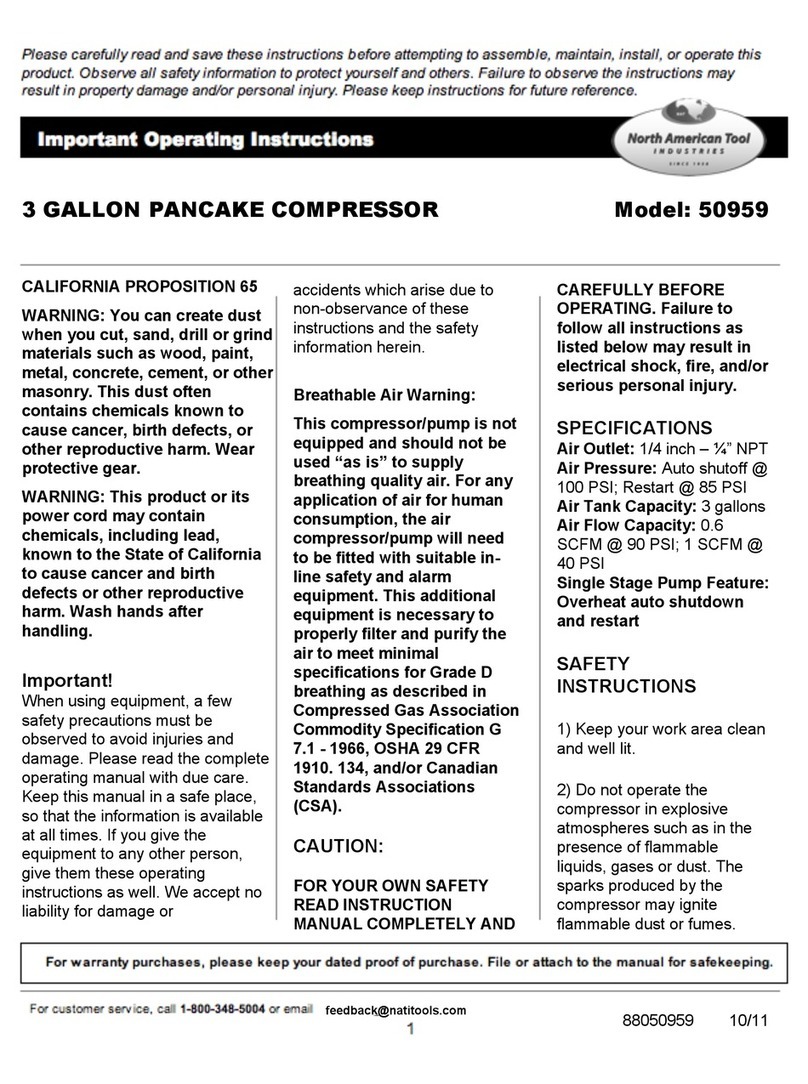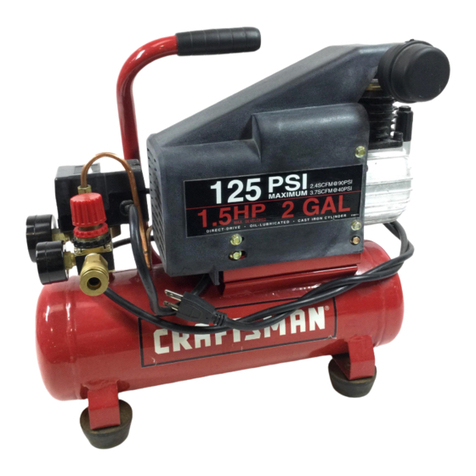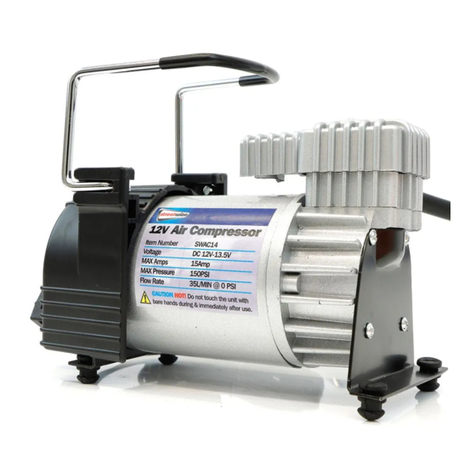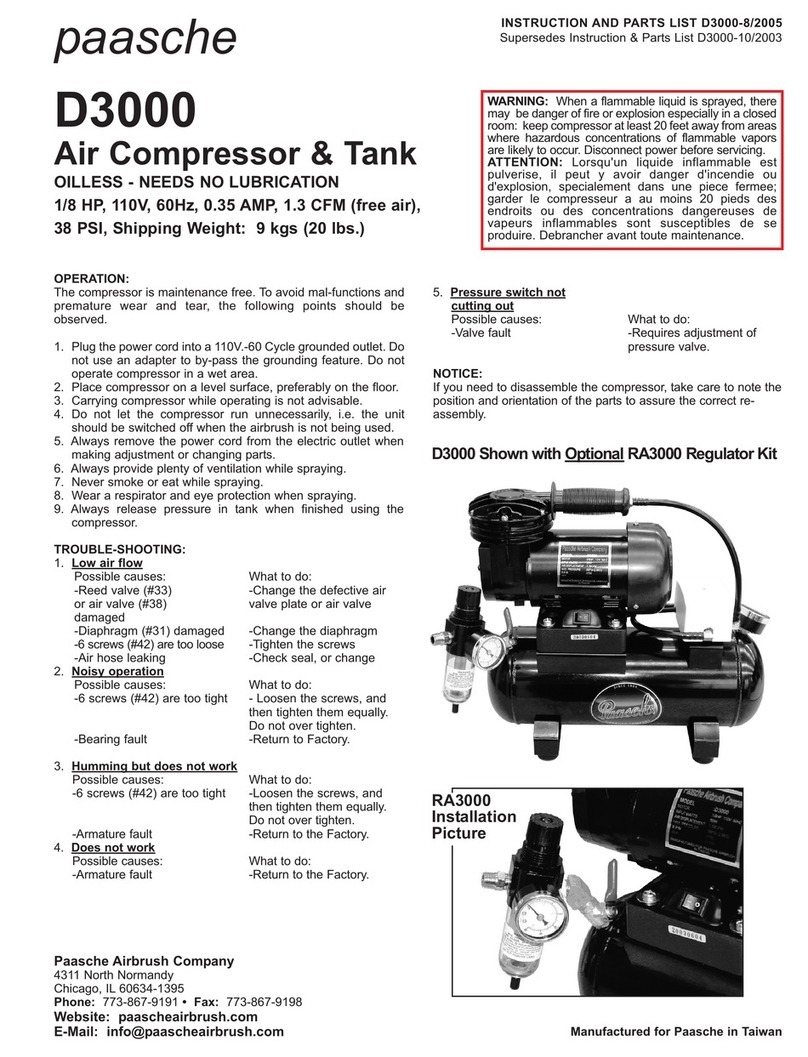North American Tool Industries 7517 Operating instructions

8807517 08/13
2 GALLON AIR COMPRESSOR
DO NOT RETURN TO
STORE. Please CALL 800-
348-5004 for parts and
service.
CALIFORNIA PROPOSITION 65
WARNING:
You can create dust when you
cut, sand, drill or grind
materials such as wood, paint,
metal, concrete, cement, or
other masonry. This dust often
contains chemicals known to
cause cancer, birth defects, or
other reproductive harm. Wear
protective gear.
WARNING: This product or its
power cord may contain
chemicals, including lead,
known to the State of
California to cause cancer and
birth defects or other
reproductive harm. Wash
hands after handling.
CAUTION:
FOR YOUR OWN SAFETY
READ INSTRUCTION MANUAL
COMPLETELY AND
CAREFULLY BEFORE
OPERATING THIS
AIR COMPRESSOR. Failure to
follow all instructions as listed
below may result in electrical
shock, fire, and/or serious
personal injury.
Specifications:
Running Horsepower: 1/3 HP
CFM @ 40PSI: 1 CFM
CFM @ 90PSI: .5 CFM
Voltage - Single Phase: 120 V
Motor RPM: 2900 RPM
Amperage: 2.6 amp
Tank Size: 2 Gallon
SAFETY WARNINGS
WARNING: Improper operation
or maintenance of this product
could result in serious injury
and/or property damage. Read
and understand all of the
warnings and safety
instructions provided before
using this equipment.
CAUTION: The air compressor
should be operated on a
dedicated 15-amp circuit. If the
circuit does not have 15 free
amps available, a larger circuit
must be used. Always use
more air hose before utilizing
extension cords. Low voltage
could cause damage to the
motor.
Risk of moving parts: If the
air compressor is in operation,
all guards and covers should
be attached or installed
correctly. If any guard or cover
has been damaged, do not
operate the equipment until the
proper
personnel have correctly
repaired the equipment. The
power cord should be free of
any moving parts, twisting
and/or crimping while in use
and while in storage.
Risk of burns: There are
surfaces of your air compressor
that while in operation and
thereafter can cause serious
burns if touched. The
equipment should be allowed
time to cool before any
maintenance is attempted.
Items such as the compressor
pump and the outlet tube are
normally hot during and after
operation.
Risk of falling: Operation of
the air compressor should
always be in a position that is
stable. Never use the air
compressor on a rooftop or
Model: 7517
For Customer Service, please call 1-800-348-5004 or
email feedback@natitools.com 1

2
elevated position that could allow
the unit to fall or be tipped over.
Use additional air hose for
elevated jobs.
Risk from flying objects:
Always wear approved safety
glasses with side shields when
the air compressor is in use. Turn
off the air compressor and drain
the air tank before performing
any type of maintenance or
disassembly of the hoses or
fittings. Never point any nozzle or
sprayer toward any part of the
body or at other people or
animals.
Risk to breathing: Avoid using
the air compressor in confined
areas. Always have adequate
space (30 cm) on all sides of the
air compressor. Also keep
children, pets, and others out of
the area of operation. This air
compressor does not provide
breathable air for anyone or any
auxiliary breathing device.
Spraying material will always
need to be in another area away
from the air compressor to not
allow intake air to damage the air
compressor filter.
Risk of electrical shock: Never
use the air compressor in the rain
or wet conditions. Any electrical
issues or repairs should be
performed by authorized
personnel such as an electrician
and should comply with all
national and local electrical
codes. The air compressor
should also have the proper three
prong grounding plug, correct
voltage, and adequate fuse
protection.
Risk of explosion or fire: Never
operate the compressor near
combustible materials, gasoline,
or solvent vapors. If spraying
flammable materials, locate the
air compressor at least 50m away
from the spray area. Never
operate the air compressor
indoors or in a confined area.
Risk of bursting: Always drain
the air compressor tank daily or
after each use. If the tank
develops a leak, then replace the
air compressor. Never use the air
compressor after a leak has been
found or tried to make any
modifications to the tank. Never
modify the air compressor’s
factory settings which control the
tank pressure or any other
function.
PARTS AND FEATURES
Drain Valve: Used to drain
condensation from the air tank.
Located on bottom of tank.
Motor Thermal Overload: The
motor has an automatic thermal
overload protector. If the motor
overheats, this protector will shut
off the motor. The motor must be
allowed 30 minutes to cool before
restarting.
Quick Connect: Offers a quick
release feature for attaching and
removing the air hose.
Air Compressor Pump: Oil free
direct driven pump that
compresses air, which is
distributed to the tank.
Check Valve: When the pump is
not in operation the valve closes
to retain air pressure inside the
tank.
Tank Safety Valve: Used to
allow excess tank pressure to
escape into the atmosphere.
This valve should only open
when the tank pressure is
above the maximum rated
pressure.
Outlet Pressure Gauge:
Indicates the outgoing air
pressure to the tool and is
controlled by the regulator.
Tank Pressure Gauge:
Indicates the reserve air
pressure in the tank.
Regulator: The regulator
controls the air pressure
coming from the air tank. To
increase the pressure, turn the
knob clockwise and to
decrease the pressure to turn
the knob counterclockwise.
INSTALLATION AND
ASSEMBLY
Lubrication and Oil
This compressor requires no
lubrication or oiling. No break
in procedures is required by
the user. This product is factory
tested to ensure proper
operation and performance.
Location of the Air
Compressor
The air compressor should
always be located in a clean,
dry, and well-ventilated
environment. The unit should
have a minimum of 30 cm of
space on each side. The air
filter intake should be free of
any debris or obstructions.
Check the air filter on a daily
basis to be sure it is clean and
in working order.

3
Extension Cords
Use only a 3-wire extension cord
that has a 3-blade grounding
plug, and a 3-slot receptacle that
will accept the plug on the
product. Make sure your
extension cord is in good
condition. When using an
extension cord, be sure to use
one heavy enough to carry the
current your product will draw.
Cords must not exceed 25 feet
and No. 12 AWG size must be
used. An undersized cord will
cause a drop in line voltage
resulting loss of power and
overheating.
Grounding Instructions
This product should be grounded.
In the event of an electrical short
circuit, grounding reduces the risk
of electric shock by providing an
escape wire for the electric
current. This product is equipped
with a cord having a grounding
wire with an appropriate
grounding plug. The plug must be
plugged into an outlet that is
properly installed and grounded
in accordance with all local codes
and ordinances (see Figure
below). Check with a qualified
electrician or service personnel if
these instructions are not
completely understood or if in
doubt as to whether the tool is
properly grounded.
WARNING: Improper installation
of the grounding plug can result
in a risk of electric shock. If
repair or replacement of the
cord or plug is necessary, do
not connect the grounding wire
to either flat blade terminal. The
wire with insulation having an
outer surface that is green with
or without yellow stripes is the
grounding wire. Check with a
qualified electrician or
serviceman if the grounding
instructions are not completely
understood, or if in doubt as to
whether the product is properly
grounded. Do not modify the
plug provided; if it will not fit the
outlet, have the proper outlet
installed by a qualified
electrician.
ASSEMBLY INSTRUCTIONS
CAUTION: Always make sure the
compressor is turned OFF before
performing any service,
maintenance, or cleaning of the
compressor.
1. Install the handle by removing
the screw and positioning the
handle in place. Re-install the
screw and tighten securely.
2. Install air-flow valve in pressure
regulator. Note: Use sealing tape
or silicon thread compound on air-
flow valve threads to prevent air
leaking. Connect the 1/4”female
connector to the air flow valve.
Remember to use the sealing
tape.
HOSE CONNECTION
Attach an air hose to the
compressor’s air outlet (air-flow
valve) with the 1/4”female
connector already attached. Then
set the desired pressure to operate
your tool. Next, connect the air
hose to the air inlet of the tool. Use
sealing tape for best air tight
connections.
OPERATING INSTRUCTIONS
To start the compressor:
1. Check to make sure the air tank
drain valve, located at the bottom
of the air tank, is fully closed.
2. Plug the power cord into the
nearest 120V, grounded, electrical
outlet.
3. Turn the compressor ON by
depressing the ON side of the
ON/OFF of the power switch.

4
To adjust the air regulator:
1. With the supplied air-flow valve
attached to the pressure regulator
and the valve handle in the OFF
position, turn the compressor ON.
When the maximum air pressure,
100 PSI, is reached as indicated
by the tank pressure gauge, the
motor will stop.
2. Turn the pressure regulator
knob to adjust the pressure
regulator. Turn the pressure
regulator knob counterclockwise
to decrease the PSI, turn it
clockwise to increase the PSI.
(Do not exceed 100 PSI) When
the regulated pressure gauge
shows the pressure that you want
to limit the compressor to, the
pressure regulator is set.
3. Between the pressure
regulator knob and the valve
body, a narrow ring acts as a
lock-ring for the knob. Rotate the
ring in a counterclockwise
direction and tighten it against the
knob to secure the setting.
4. Attach hose to the air-flow
valve, then tool to hose. Turn on
the air-flow valve to supply air
pressure shown on gauge to the
tool.
NOTE: When the maximum air
pressure, 100 PSI, is reached as
indicated by the tank pressure
gauge, the motor will stop. The
compressor will automatically
restart when the air pressure
drops below 85 PSI.
To stop the compressor:
1.Push the ON/OFF power switch
to the OFF position.
2. Turn air-flow valve to OFF.
Press trigger on tool to relieve air
pressure in hose. Disconnect
hose from air-flow valve.
3. Relieve the air tank pressure
and remove moisture by opening
the tank drain valve. Turn the
valve slowly counterclockwise
until the pressure is relieved.
Then, retighten the drain valve.
4. Allow the air compressor to
completely cool. Then store the
unit in a clean, dry, safe location
out of the reach of children.
INSPECTION, MAINTENANCE,
& CLEANING
1. WARNING: Make sure the
compressor is OFF, the unit is
unplugged from its electrical
outlet, and the air is drained from
the tank before performing any
inspection, maintenance, or
cleaning procedures or leaving it
unattended.
2. Before each use, inspect the
general condition of the air
compressor. Check for loose
screws, misalignment, or binding
of moving parts, cracked or
broken parts, damaged electrical
wiring, loose
air fittings, and any other
condition that may affect the safe
operation of the compressor. If
abnormal noise or vibration
occurs, have the problem
corrected before further use. Do
not use damaged equipment.
3. Daily, purge the air tank of all
air and moisture to prevent
corrosion. To do so, slowly and
carefully unscrew (no more than
four threads) the tank drain valve
until the compressed air and
condensation begins to be
released from the tanks. Allow
sufficient time for all of the air and
condensation to escape from the
tank. Then, firmly re-tighten the
drain valve.
4. To replace fuse, unscrew the
fuse and replace with a 250V, 3A
fuse.
5. Caution: All maintenance,
service, or repairs not mentioned
in this manual should only be
performed by a qualified service
technician.

5
Troubleshooting
Immediately unplug compressor from
its electrical outlet. Do not operate
compressor until a qualified service
technician can replace pressure
switch.
Replace safety valve
Close drain valve
Replace safety valve
Have a qualified service technician
replace pressure controller
Make sure compressor is plugged into
a working 120V, grounded, electrical
outlet
Replace Fuse
Solution
Defective pressure switchPressure switch will not
turn off compressor at 100
PSI
Defective safety valveSafety valve releasing
Drain valve not fully closed
Air leak in safety valve
Defective pressure controller
Low pressure
Loose Electrical Connections
Blown Fuse
Compressor will not start
Possible CauseProblem

6
North American Tool Industries (NATI) makes every effort to ensure that this product meets high
quality and durability standards. NATI warrants to the original retail consumer a 1-year limited
warranty from the date the product was purchased at retail and each product is free from defects in
materials. Warranty does not apply to defects due directly or indirectly to misuse, abuse, negligence,
or accidents, repairs or alterations, or a lack of maintenance. NATI shall in no event be liable for
death, injuries to persons or property, or for incidental, special, or consequential damages arising from
the use of our products. To receive service under warranty, the original manufacturer part must be
returned for examination by an authorized service center. Shipping and handling charges may apply. If
a defect is found, NATI will either repair or replace the product at its discretion.
DO NOT RETURN TO STORE
For Customer Service:
Email: feedback@natitools.com or Call 1-800-348-5004

8807517 08/13
2 GALLON AIR COMPRESSOR
For Customer Service, please call 1-800-348-5004 or
email feedback@natitools.com 7
MODEL: 7517

Part # Description Qty Part # Description Qty
1 Motor 1 35 Power Cord 1
2 Crank 1 36 Motor Cover 1
3 Screw 1 37 Circuit Board 1
4 Bearing (608-2RS) 1 38 Screw (M4 x 8) 2
5 Connecting Rod 1 39 Washer 1
6 Silica Gel Ring (21.2 x 2.5) 1 40 Wire Clip 1
7 Piston Ring 1 41 Screw (M4 x 15) 2
8 Paper Pad 1 42 Nut 4
9 Hoop 1 43 Fuse (3 Amp) 1
10 Cylinder 1 44 Fuse Box 1
11 Cylinder Washer 1 45 Power Switch 1
12 Silica Gel Ring (31 x 2) 1 46 Screw (M5 x 16) 2
13 Cylinder Head 1 47 Handle 1
14 Connector 2 48 Handle Soft Grip 1
15 Silica Gel Ring (31.5 x 1.8) 1 49 Cords 1
16 Screw (M4 x 40) 4 50 Flat Washer 1
17 Flat Washer 5 51 Zip Tie 1
18 Spring Washer 5 52 Rubber Sheath 1
19 Fan 1 53 Air Tank 1
20 Screw (M4 x 10) 1 54 Drain Valve 1
23 Tube 1 55 Rubber Foot 4
24 Pressure Regulator 1 56 Pressure switch 1
25 Safety Valve 1 57 Ball 1
26 Tank Pressure Gauge 1 58 Spring 1
27 Two-Way Valve 1 59 Screw (M6 x 15) 4
29 Muffler Board 1 60 Flat Washer 6
30 Screw (M3 x 6) 4 61 Copper Tube 1
31 Copper Connector Rod 2 62 Screw (M6 x 20) 4
32 Copper Hoop 2 70 Regulated Pressure Gauge 1
33 Screw (M6 x 25) 4 71 Air Flow Valve 1
34 Damping Pad 1 72 1
Table of contents
Other North American Tool Industries Air Compressor manuals
Popular Air Compressor manuals by other brands
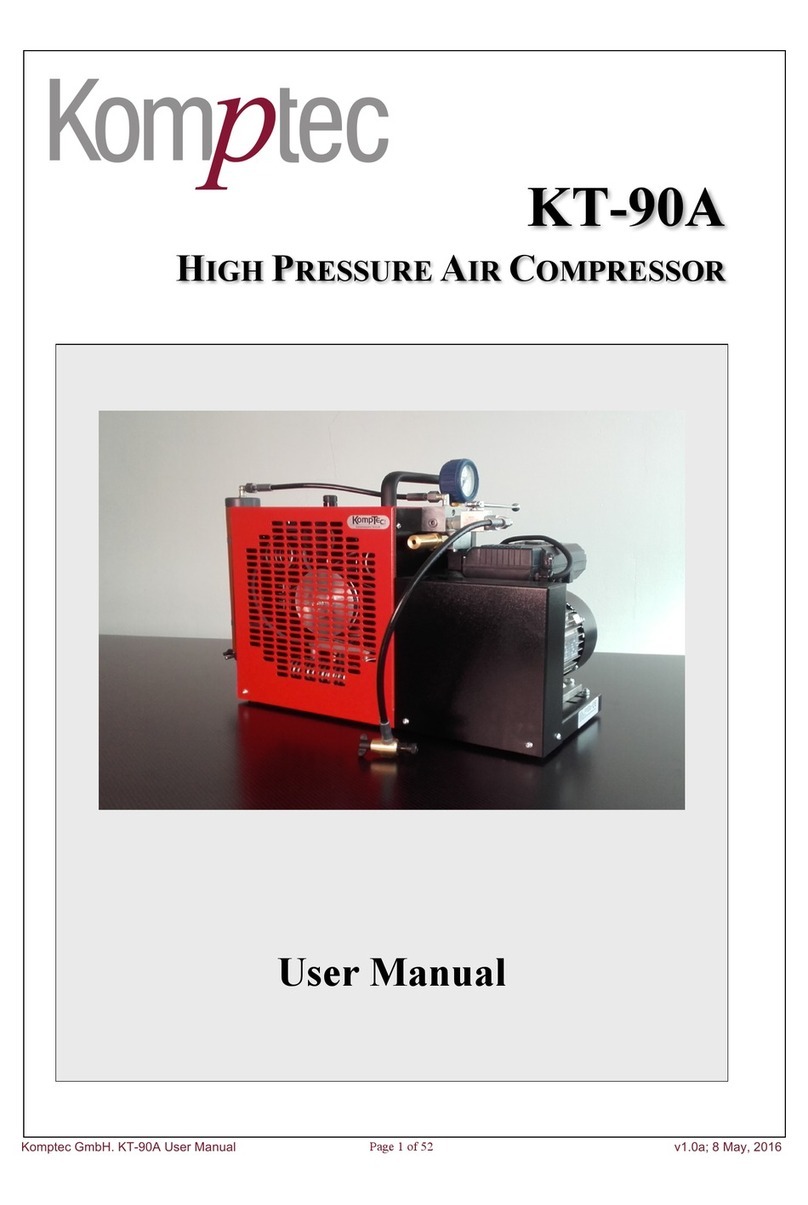
Komptec
Komptec KT-90A user manual

Sanborn Mfg
Sanborn Mfg 200-2156 Operator's manual

California Air Tools
California Air Tools 10020C-22060 owner's manual
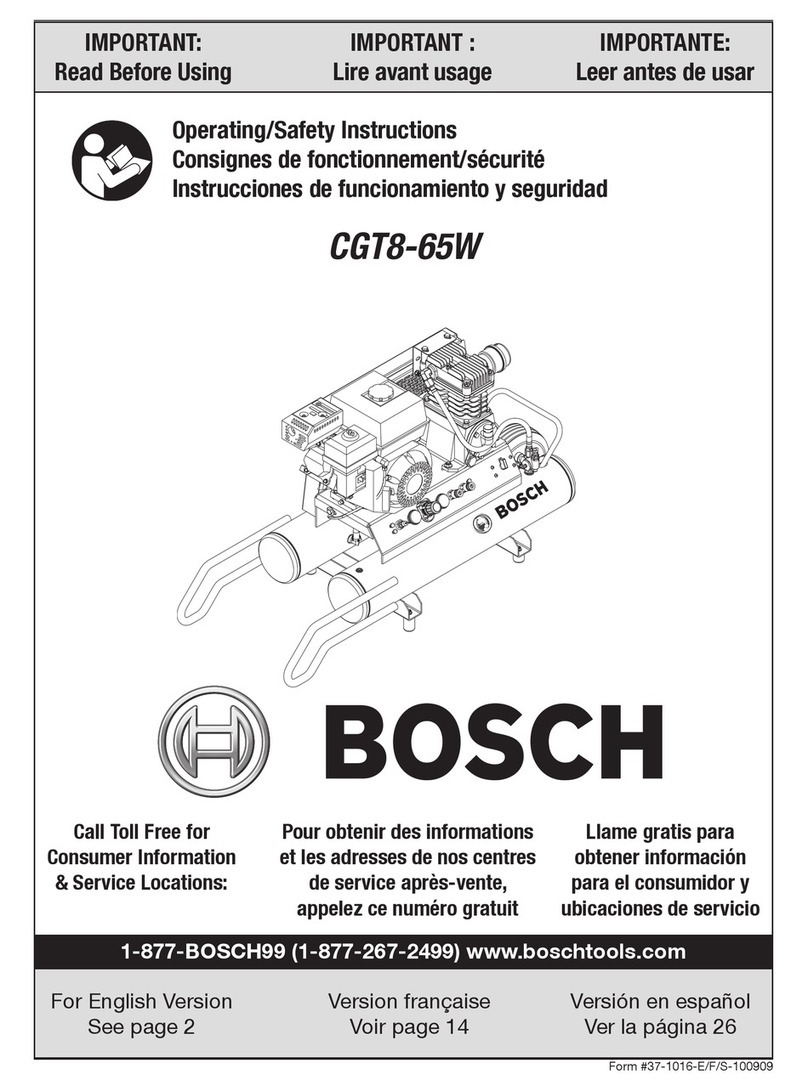
Bosch
Bosch CGT8-65W Operating/safety instructions
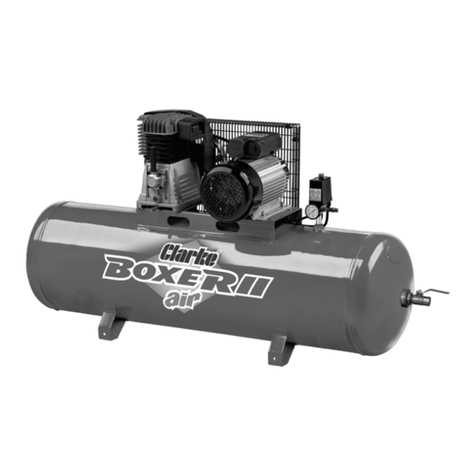
Clarke
Clarke BOXER II 18/200 Operation & maintenance instructions
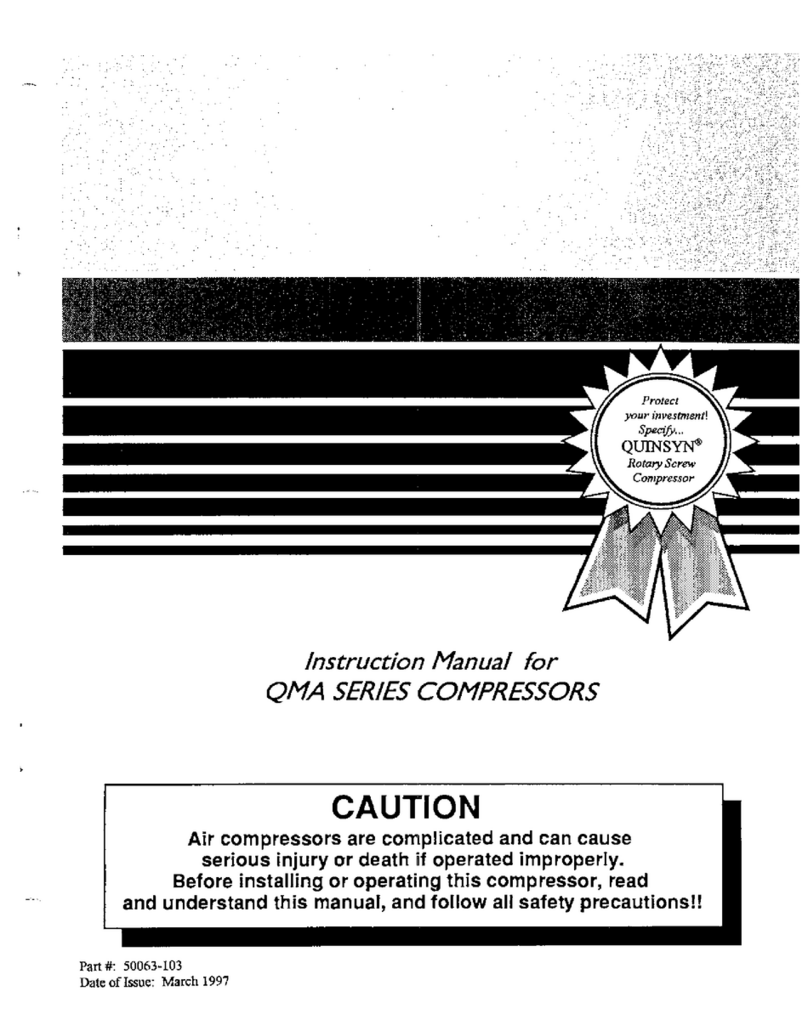
Quincy Compressor
Quincy Compressor QMA Series instruction manual
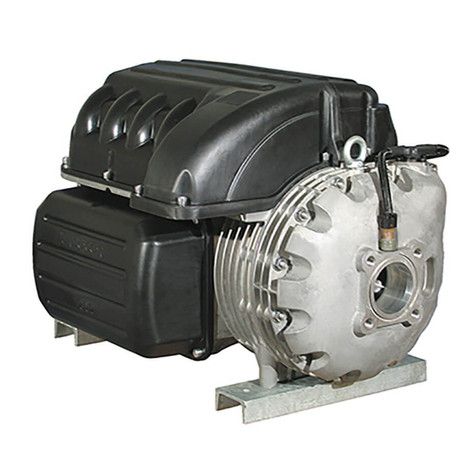
Danfoss
Danfoss Turbocor TT-300 user manual
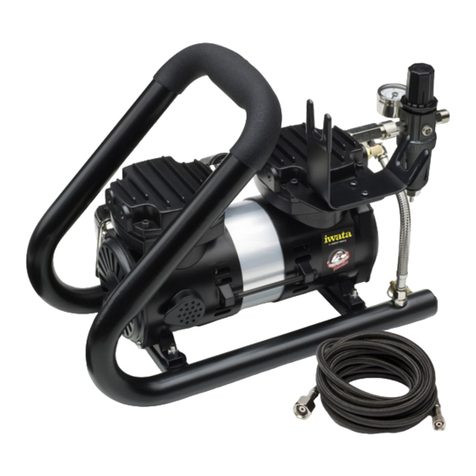
Anest Iwata
Anest Iwata IS875HT instruction manual

Sullair
Sullair 3007 Operators manual & parts lists
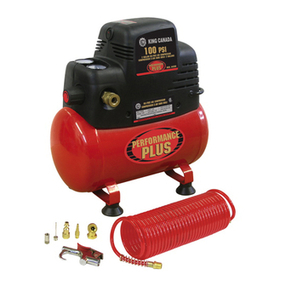
King Canada
King Canada 8439 instruction manual
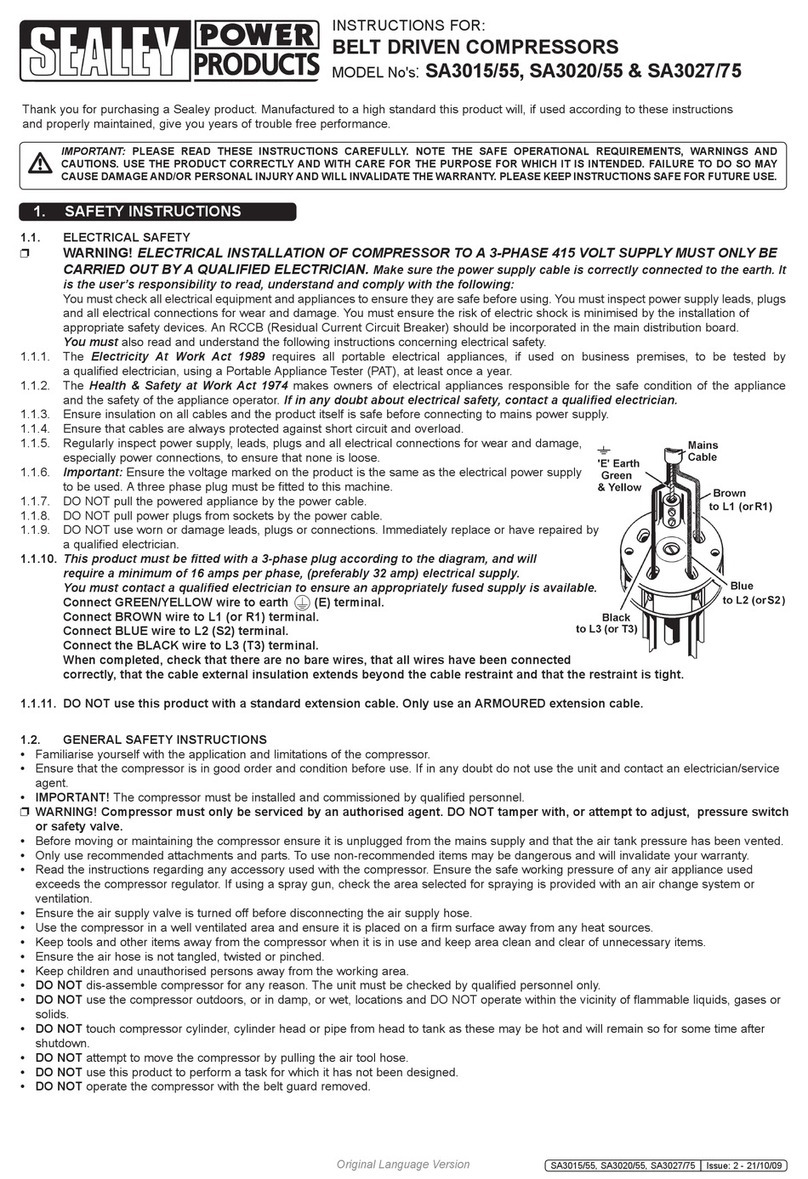
Sealey
Sealey SA3015/55 instructions

Pittsburgh Automotive
Pittsburgh Automotive 63184 Owner's manual & safety instructions
